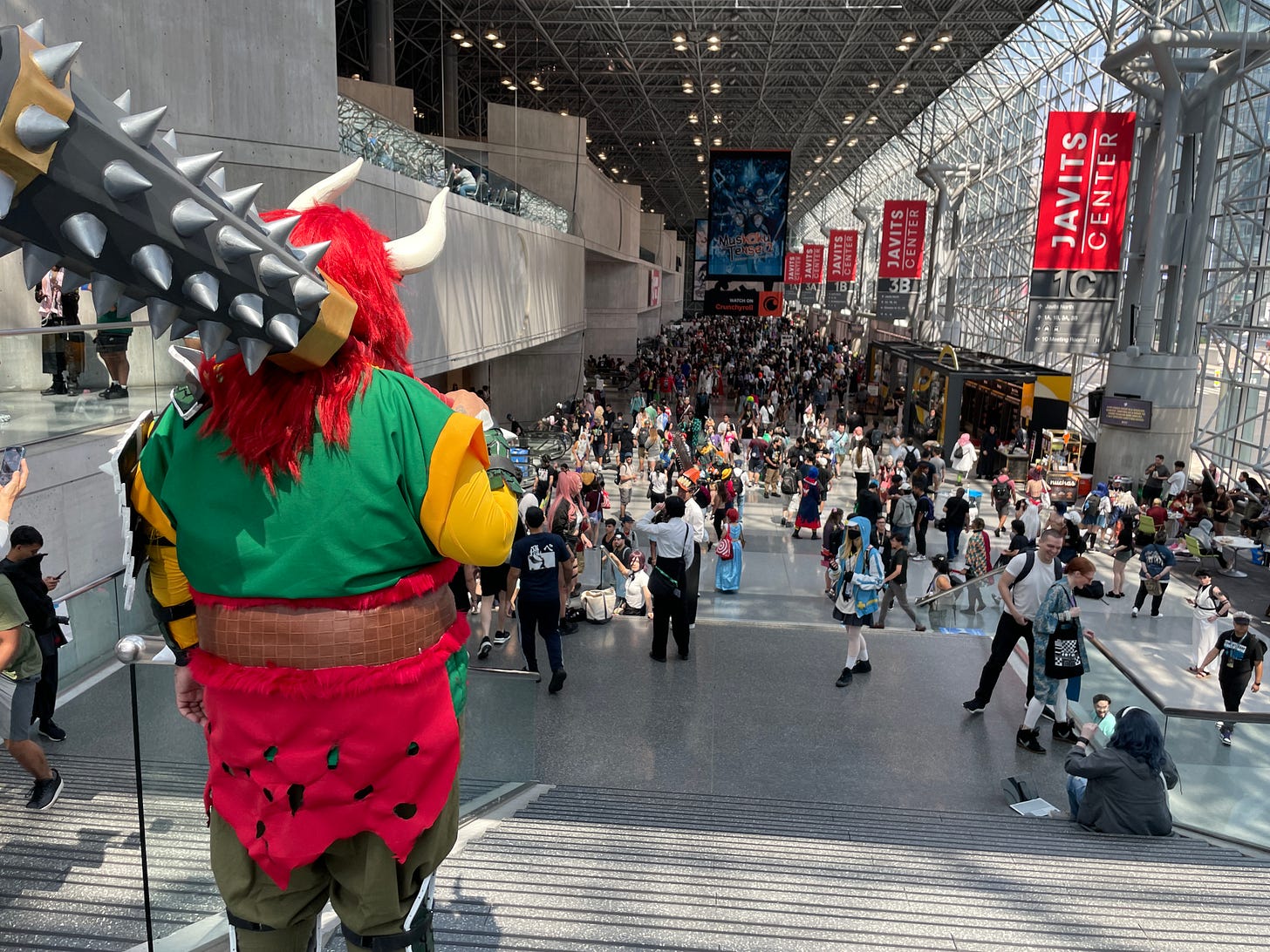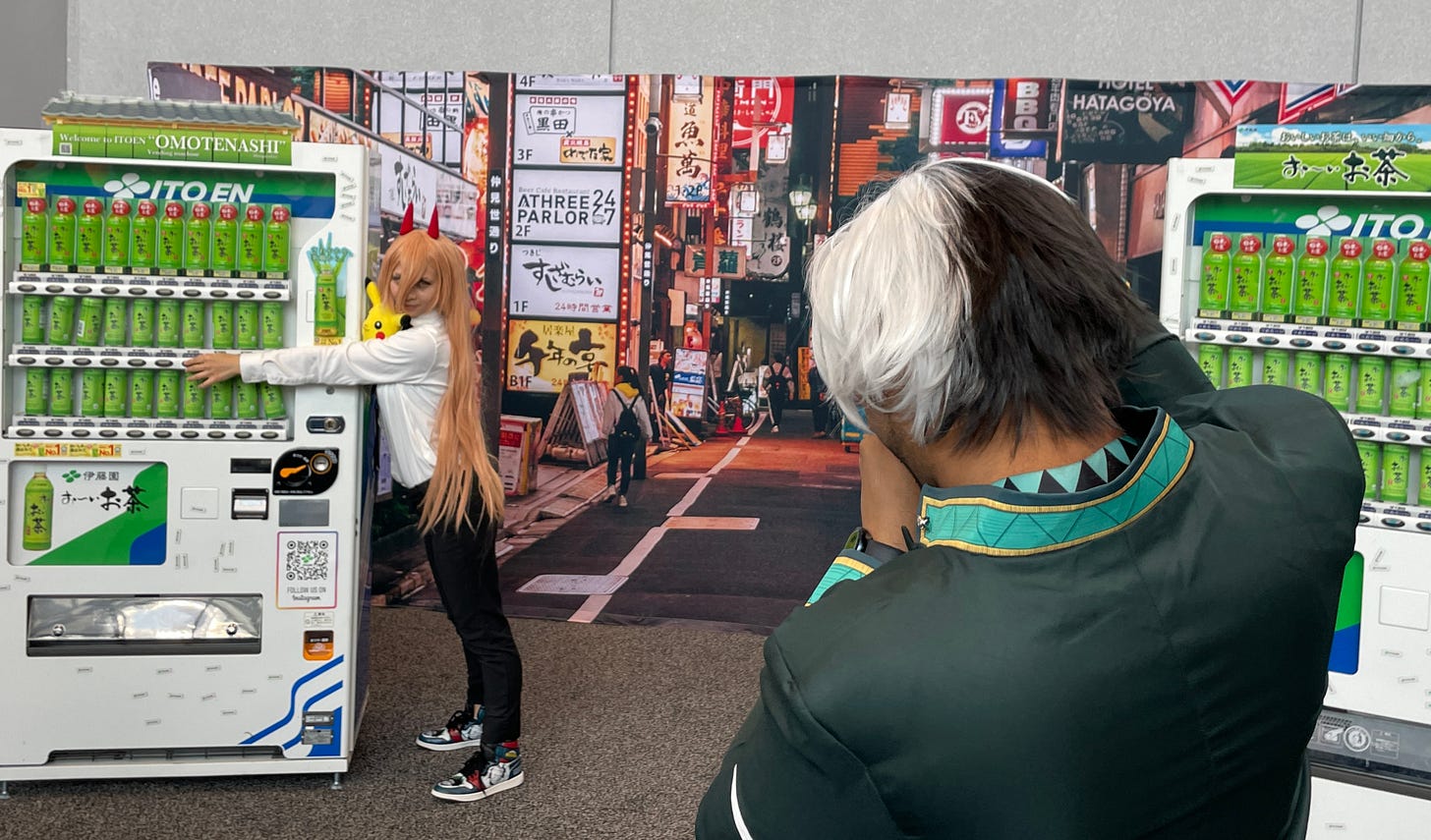The kids are all right
The world’s falling apart. Can fandom save us?
“In fact the whole of Japan is a pure invention,” wrote Oscar Wilde in 1889, at the height of a craze for things Japanese then sweeping Europe and the United States. “There is no such country. There are no such people.” This bit, from a play called The Decay of Lying, is well known. It gave my book, and this newsletter, their names.
Less quoted is the remainder of the conversation, in which Wilde’s avatar declares that “if you desire to see a Japanese affect, you will not behave like a tourist and go to Tokio. On the contrary, you will stay at home and steep yourself in the work of certain Japanese artists.” He singles out Hokusai and Hokkei, both masters of the artform known as the ukiyo-e print. If you want to experience the real Japan, Wilde cheekily suggests, there’s only one place to find it: in illustrated fantasies.
Pure Invention used the lens of hit consumer products to explore why the world loves things from Japan. They’re often well made, but that isn’t enough; plenty of countries make fine products. Japanese creations’ pull, their gravity, comes from the fact that they possess a knack for answering questions the world hasn’t thought to ask, to fill needs we didn’t know we had. Nobody asked for a Walkman, or knew we’d lavish the same affection on a virtual Tamagotchi as a real pet, or that we had a burning need to express our worst political selves on anonymous online imageboards, or that we craved life-changing tidying magic. Yet we incorporated these things into our lives and identities from virtually the first moments of contact, each hit a fractal echo of those Victorian-era fads for Japanese arts and crafts and fashions.
Japanese creators grasped these things earlier than we did because the nation was “several measurable clicks down the timeline,” as William Gibson put it in 2001. Japan didn’t possess a time machine, of course, but postwar Japan really did reach the future ahead of the Western world in many ways, in its urbanization and its ageing demographics, in its social ills and economic triumphs and crashes. The things Japan made for its own citizens — struggling in a world where the future felt less bright and more diminished, connected by new technologies but still isolated and lonely, desperate for stimulation, nourishment, escape — all of it presaged the hungers of advanced societies around the world.
One of the biggest things we didn’t know we craved was manga, and the closely associated artform of anime, the pair orbiting each other like binary stars, their combined power sucking in global attention like black holes. When I say “we” I am speaking societally, because there have long been observers and aficionados of these mediums in the West. One of the earliest was Fred Schodt, author of the seminal Manga! Manga! The Art of Japanese Comics, a book that opened many eyes, including my own, when it arrived in 1983. I had the pleasure of sitting down to talk with him at AnimeNYC this last weekend, in a discussion you can view online here.
In September of 1983, right around the time Fred’s book hit shelves, fans of “Japanimation” (as anime was widely called in English then) gathered in the ballroom of a tiny Dallas hotel for an event called Yamatocon. They numbered just over a hundred. In August of 2024, fans of Japanese anime, manga, games, and music, gathered in Javits Center over three days for AnimeNYC. They numbered a hundred and one thousand.
Fandoms, and fan gatherings, are another way that Japan got to the future ahead of the West. America had the pioneering World Science Fiction Convention (first convened in 1939) and, by my adolescence, the San Diego Comic-Con and countless Star Trek gatherings around the country. But these were dwarfed in scale by the events organized by fans of Japanese illustrated entertainment. Comic Market, for creators and consumers of fan-fiction based on anime and manga, hit a hundred thousand visitors way back in 1989. In December of 2019, just before pandemic, its attendance hit three quarters of a million visitors. These numbers just go to show how organized the fan scene is in Japan.
AnimeNYC 2024 was the first anime convention I ever attended in the United States. American anime conventions didn’t exist beyond isolated local get-togethers when I was growing up, and I’ve been living in Japan since 2003. So everything was new to me. The atmosphere in the Javits Center, which hosted the show, was kinetic, even a little overwhelming. I knew anime was big abroad. I didn’t realize it was this big. This was a happening.
Booming soundtracks filled the air, massive banners for new productions hung from the rafters, and fans packed the floors. In the scrum I found myself shoulder to shoulder with people carrying elaborate prop weapons or covered head to toe in body paint, embedded in the crowd, our forward progress halting occasionally as admirers of one character or another asked for photos. Nobody minded. The crowds and interactions were precisely what everyone was there for. This was their tribe. It was chaos but a joyful sort of chaos, the diverse crowd bound by their shared interests, kind of like raves of old, only with a lot more streaming and social media in the mix.
We live in a divisive era, a time when it seems almost impossible for a majority of people to see eye to eye on fundamental issues affecting our society. That anything could unite large numbers of citizens seems miraculous. That it might be fantasies from Japan seems almost fantastical. It wasn’t so long ago that manga and anime were a niche among niches in American pop culture. Back in the Eighties, you couldn’t watch anime or read manga in “realtime,” along with Japanese fans, because so few of them were ever broadcast or published in English-speaking markets. You wouldn’t even get stuffed into your locker by the jocks for liking them, because none of them knew what they were. Today, anime is more popular than football among Gen Z. This is pretty incredible stuff.
But it makes sense. Thanks to the boom and bust cycles of what, for lack of a catchier phrase, some call late capitalism, advanced nations around the world have now hit those same demographic and socioeconomic milestones that long made Japan Japan, in the eyes of the West. Now we’re Japan. We’re older, we’re lonlier, we’re poorer, we’re more desperate for escape than ever before. Japan isn’t an outlier anymore, nor is it the exotic backwater or economic rival that it was to the Boomer generation. Japan is a treasure chest of fantasies for the world, because Japan and West have synchronized with one another. And the proof can be seen in a hundred thousand Americans, of all races, genders, abilities, and backgrounds, gathered in celebration of the same anime and manga that enthrall Japanese fans, in a city on the opposite side of the planet.
I’m often asked by readers: if Japan’s no longer the future, what’s next? For a long while I didn’t have a clear answer to this, because so much of the planet was stuck in pandemic-induced cultural stasis. But at AnimeNYC I think I saw the beginnings of an answer. Japanese fantasies helped the world survive lockdown — that’s why Demon Slayer was one of the top grossing movies globally, and Ninenendo’s Animal Crossing New Horizons grossed two billion USD in 2020. But AnimeNYC shows this wasn’t an isolated blip on the radar.
It seems Japan’s illustrated artforms have the power to link us like none other. And they feed into something that America possesses, but Japan lacks: diversity. The diversity of an immigrant country, with all of the dynamic instability and creativity that erupts from putting so many people of so many backgrounds into close proximity. In New York I saw a potential future where the gulfs that separate us were bridged by fandoms: people coming together to celebrate something they loved. Japanese anime blazed the way, but it’s just as true of other adult fandoms as well, whether “Swifties” or K-pop stans or whatever else people find to rally around that isn’t driven by exclusion, victimhood, outrage, or hate.
Unlike the Victorians whom Oscar Wilde was tweaking with his writing, the fans of modern-day anime and manga aren’t content with pictures alone. I heard a surprising amount of Japanese being spoken by con-goers, and the Japan National Tourist Organization had a booth set up in the dealer’s room, doing a brisk business pitching trips to an audience that didn’t need much convincing. Wilde was being ironic when he said that Japan didn’t exist. But when he said the best way to experience it was through illustrated fantasies, he turned out to be absolutely right.





It’s surreal to see so many people outside of Japan so openly into manga now. I work for a publisher in Osaka doing translation and lettering, and it can be kind of frustrating how this moment of things synchronizing, people engaging with everything down to even a niche recent mangaka, just goes over the heads of some of the corporate wigs making the calls on the direction of it. That’s just how it tends to go, and I’m endlessly fascinated by this never ending “gap” between the people interested in the entertainment coming out of Japan and the entities making it happen, but I can’t help but imagine how much more it could be if there were things like an interest in multilingual marketing, more active involvement in conventions outside of Japan, etc.
During my decade in Japan during the late eighties and early nineties, I also took note of the diversity gap from the queer perspective. The notion of 出る釘が打たれる really hit home. That said, my (Japanese) husband and I are still hoping to return to Japan, to retire there, and the changes I've seen since leaving in 1998 are encouraging. Japan is still my future.